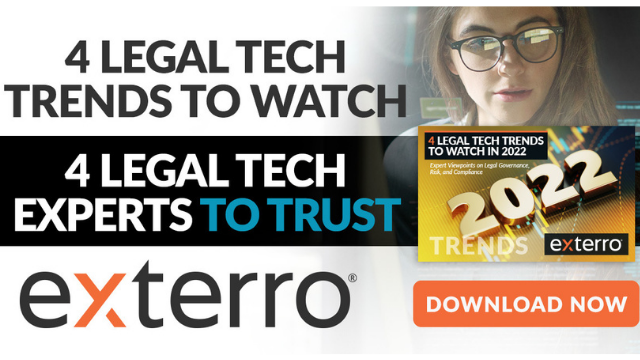[Editor’s Note: EDRM is proud to amplify our Guardian Plus partner, Exterro.]

Looking back over the past two years, it’s hard to overstate the amount of change that has taken place. Trends that were percolating for years slammed into overdrive as Covid forced businesses to rapidly shift to remote workplaces and companies gathered more data than ever on their customers, while meanwhile trying to comply with a patchwork quilt of data protection regulations.
In response to Covid, organizations implemented new technologies like Zoom, Slack, Teams, and Webex faster than they could vet, validate, and set up governance, compliance, and retention policies for them.
Michael Landau, Treasurer for ARMA International
While companies made business decisions out of necessity, in many instances, the legal department’s traditional advisory role got bypassed, at least temporarily, in the interest of adapting quickly to seismic changes. But two years into the pandemic, organizations–and their legal teams–must come to terms with these trends. We may not be returning to pre-Covid normal anytime soon; rather, we will be settling into a new world defined by the technologies we’ve adopted.
Two trends that organizations must reckon with in 2022 are particularly important to legal departments: the rapid adoption of a variety of new technology platforms to facilitate remote work and the increasing risk of conflict between our ability to store and process data and the state, national, and international regulations governing data privacy. Exterro recently spoke with four legal technology experts to identify these key trends and provide insight into best practices to address them in its new resource for in-house legal professionals, 4 Legal Tech Trends to Watch in 2022.
Trend #1: The Long-term Impact of Remote Technology
Michael Landau, Treasurer for ARMA International, explains, “In response to Covid, organizations implemented new technologies like Zoom, Slack, Teams, and Webex faster than they could vet, validate, and set up governance, compliance, and retention policies for them. Some companies moved so fast, they didn’t have a chance to determine if the platforms had the appropriate data governance features and capabilities. Organizations are going to have to re-evaluate and implement governance policies around these technologies to maintain compliance, especially as relates to e-discovery.”
Legal departments typically advocate for caution and incremental change, but Covid and the need to work remotely right away didn’t allow for caution. Business carried on, but often over hastily implemented technology platforms. As legal matters arise, organizations must implement policies to preserve, collect, and produce ESI from these platforms or run the risk, as Landau put it, of “[standing] in front of a court or regulator and [answering] a question, ‘I don’t know.’”
Trend #2: The Increase of Data Privacy Litigation
New regulations governing personal data are resulting in an increase in cybersecurity, biometric, and privacy litigation that will fuel the demand for more automation in legal technology.Jenny Hamilton, General Counsel at Exterro, observes, “Many of the core privacy principles of GDPR are being enacted by various states in the US. These laws mandate active data management; organizations must put their data houses in order. Start by asking questions like, ‘Do you need to collect biometrics to conduct business operations?’ Regulators in Europe are issuing fines for data management missteps on fundamentals like not following retention schedules or disposing of data that are personal, private, and highly sensitive.”
Organizations must understand their data in order to be able to comply with data privacy regulations. Knowing the data starts with a data inventory. Hamilton advises companies to “Audit your data before you have an incident or a breach. Is sensitive data where you expect it to be, or is it all over the place? And let that drive a plan to clean it up. Keep what you need for business purposes, and dispose of unnecessary PII, biometric or otherwise.”
Learn all about these and other key trends in legal governance, risk, and compliance in the Exterro whitepaper, 4 Legal Tech Trends to Watch in 2022.

